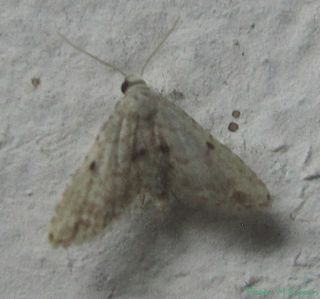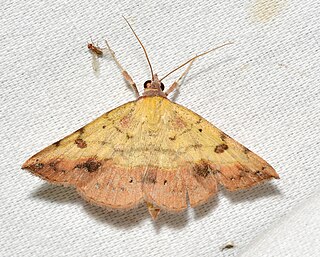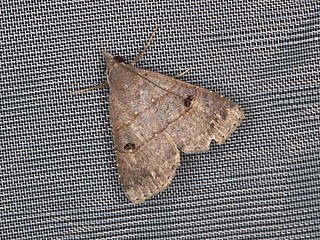
Herminia is a genus of litter moths of the family Erebidae. The genus was described by Pierre André Latreille in 1802. It was treated as a synonym for Polypogon for some time.
Aglaonice is a genus of moths of the family Erebidae. The genus was erected by Heinrich Benno Möschler in 1890.

Araeopteron is a genus of moths of the family Erebidae. The genus was erected by George Hampson in 1893.

Callistege is a genus of moths in the family Erebidae.

Chytolita is a monotypic litter moth genus of the family Erebidae erected by Augustus Radcliffe Grote in 1873. Its only species, Chytolita morbidalis, the morbid owlet moth or morbid owlet, was first described by Achille Guenée in 1854. It is found in large parts of North America, from coast to coast in the north and south to North Carolina, Texas and Florida in the west. The habitat consists of deciduous woods and edges.
Janseodes is a monotypic moth genus of the family Erebidae erected by Pierre Viette in 1967. Its only species, Janseodes melanospila, was first described by Achille Guenée in 1852. It is found in India, South Africa and the US state of Florida.

Isogona is a genus of moths of the family Erebidae. The genus was erected by Achille Guenée in 1852.
Deinopa is a genus of moths of the family Erebidae erected by Francis Walker in 1856. The genus was previously classified in the subfamily Calpinae of the family Noctuidae.
Glympis is a genus of moths of the family Erebidae. The genus was erected by Francis Walker in 1859.

Hemeroplanis is a genus of moths of the family Erebidae. The genus was erected by Jacob Hübner in 1818.
Homocerynea is a monotypic moth genus of the family Erebidae. Its only species, Homocerynea cleoriformis, was found in the US state of Arizona. Both the genus and species were erected by William Barnes and James Halliday McDunnough in 1913.

Hormoschista is a monotypic moth genus of the family Erebidae described by Heinrich Benno Möschler in 1890. Its single species, Hormoschista latipalpis, the double-lined brown moth, was first described by Francis Walker in 1858. It is found in eastern North America and the Caribbean.

Hypenodes is a genus of moths of the family Erebidae erected by Henry Doubleday in 1850.

Hyperstrotia is a genus of moths of the family Erebidae. The genus was erected by George Hampson in 1910.

Hypsoropha is a genus of moths of the family Erebidae. The genus was erected by Jacob Hübner in 1818.
Parahypenodes is a monotypic moth genus of the family Erebidae. Its only species, Parahypenodes quadralis, the masked parahypenodes moth, is found in the Canadian province of Quebec. Both the genus and species were first described by William Barnes and James Halliday McDunnough in 1918.
Phlyctaina is a monotypic litter moth genus of the family Erebidae. Its only species, Phlyctaina irrigualis, is found in North America. Both the genus and species were first described by Heinrich Benno Möschler in 1890.
Proroblemma is a genus of moths of the family Erebidae. The genus was erected by George Hampson in 1910.

Prosoparia is a genus of moths of the family Erebidae. The genus was erected by Augustus Radcliffe Grote in 1883.

The Hypenodinae are a subfamily of moths in the family Erebidae. Adult moths of most species of this subfamily lack small, simple eyes near the large, compound eyes and have quadrifine (four-veined) hindwing cells. The micronoctuid moths are an exception because they possess simple eyes and bifine (two-veined) hindwing cells.











